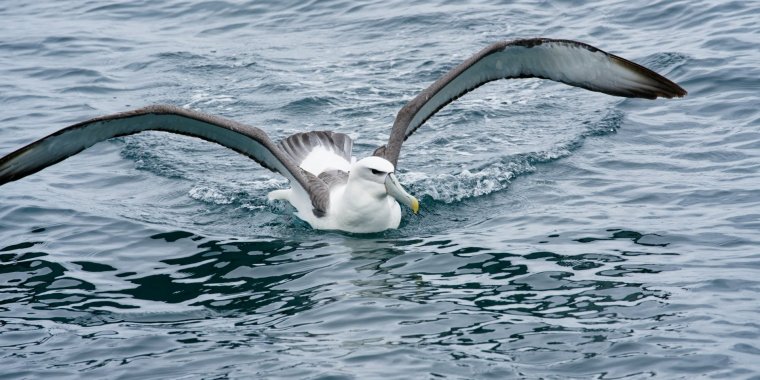| Science |
Highly-sensitive beaks could help albatrosses and penguins find their food
An international team of researchers, led by the University of Cambridge, studied over 350 species of modern birds and found that seabirds have a high density of sensory receptors and nerves at the tip of their beaks, which has been previously identified in specialised tactile foragers such as ducks.

An albatross landing on the ocean. Photo: Colin Watts/Unsplash
The researchers say this touch-sensitive region could have come from a common ancestor, and further work is needed to determine whether it serves a specific function in modern birds.
Further study of their beaks and food-gathering behaviour could help conserve some of these birds, many of which are at threat of extinction.
In the same way as humans and other primates use their hands, birds use their beaks to interact with the world around them.
Some birds have specialised touch-sensitive areas at the tips of their beaks to help them find food, but since this ability has not been widely studied, it’s not known how the phenomenon evolved or how widespread it is.
“Many scientists had assumed most birds had touch-sensitive beaks, but we hadn’t investigated it enough to know whether it’s a common ability, or whether it’s limited to particular families of birds,” said lead author Dr Carla du Toit from Cambridge’s Department of Earth Sciences.
One group that hasn’t been well studied is the large group of seabirds called Austrodyptornithes, which includes albatrosses, petrels, and penguins.
Du Toit and her colleagues from the UK and South Africa conducted a study of 361 modern bird species, based on fossil and skeletal records, as well as birds that had been accidentally killed by fishing lines and nets.
The team focused on the beaks of these birds, how they are constructed and connected to their nerves and blood vessels.
The researchers found that albatrosses and penguins have organs with high density sensory receptors and high concentrations of nerves in their beaks, which is more common in specialised foragers such as ducks.
This is the first time that this functionality has been observed in seabirds.
These touch-sensitive beaks might help seabirds find food at night or underwater, as they might enable the birds to detect tiny vibrations from potential prey.
Some birds that are already known to have touch-sensitive beaks use them to detect tiny underground vibrations from worms, for example.
However, these sensitive areas could also be a ‘leftover’ trait from a common ancestor that doesn’t have a specific function in modern birds, like the beaks of ostriches and emus.
Further studies in live birds will be needed to establish the exact purpose of these touch-sensitive areas, which may also help determine how the ability evolved.
“In humans and other primates, our sensitive hands and fingers allowed us to master a huge range of environments,” said du Toit.
“Beaks are analogous to hands in a way, but this is the first time we’ve seen touch-sensitive beaks in seabirds. It’s remarkable that no one has ever really studied this in detail, considering that we all learn about evolution from the beaks of Darwin’s finches in school.”
The researchers say their findings could potentially play a role in conserving some of these birds. Of the 22 known species of albatross, 15 are threatened with extinction and two are listed as critically endangered.
One of the big threats to albatrosses is commercial longline fishing, which kills an estimated 100,000 of the birds per year, when they get tangled in the lines and drown.
According to du Toit, if scientists can better understand how these birds get their food, it could be used to help protect them.
“Much further work is needed, but if albatrosses and other seabirds are able to detect vibrations from potential prey via their beaks, it could be possible to attach some sort of device to longlines that could repel them, so they are less likely to get caught,” said du Toit.
“Of course, the bigger threats to birds like albatrosses are climate change, rising ocean temperatures, plastic pollution and falling fish stocks, but if there’s a way to reduce the risks to seabirds in even a small way, then that’s incredibly valuable. These are such special birds and I’ve been interested in them for as long as I can remember.”
YOU MAY ALSO LIKE





